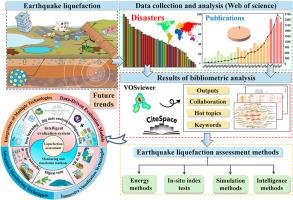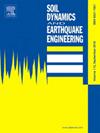Knowledge structure and research progress in earthquake-induced liquefaction assessment from 2000 to 2023: A scientometric analysis incorporating domain knowledge
IF 4.2
2区 工程技术
Q1 ENGINEERING, GEOLOGICAL
引用次数: 0
Abstract
Earthquake-induced liquefaction is a severe geological hazard that poses substantial risks to human safety making its evaluation critical. Despite prolonged discussions in academia and engineering, contemporary literature on earthquake-induced liquefaction assessment primarily focuses on specific methodologies, lacking a comprehensive overviews. This study systematically analyzed 824 research publications on earthquake-induced liquefaction assessment spanning from 2000 to 2023 within the Web of Science Core Collection (WoSCC) utilizing bibliometric approaches, including Citespace and VOSviewer. The primary objective was to meticulously analyze and explore the earthquake-induced liquefaction assessment field through bibliometric methods. The analysis reveals a steady increase in research output, transitioning from foundational theoretical development to advanced methodological innovations. Furthermore, a complete understanding of the research dynamics in this domain has been established by analyzing the publication trends, collaborative networks across journals, countries, institutions, and authors, and the evolution of significant research themes. Additionally, various techniques employed for earthquake-induced liquefaction assessment, including in-situ experiments, earthquake energy methodologies, numerical modeling approaches, and artificial intelligence methods, were explored, elucidating their characteristics and limitations. Finally, this study synthesizes the advancements and trends in earthquake-induced liquefaction assessment over recent decades, while also considering future research directions. It offers valuable insights into the methodologies for assessing earthquake-induced liquefaction and outlines potential avenues for future exploration.

2000 年至 2023 年地震诱发液化评估的知识结构和研究进展:纳入领域知识的科学计量分析
地震诱发的液化是一种严重的地质灾害,对人类安全构成巨大风险,因此对其进行评估至关重要。尽管学术界和工程界对地震诱发液化评估进行了长期讨论,但当代有关地震诱发液化评估的文献主要集中在具体方法上,缺乏全面概述。本研究利用 Citespace 和 VOSviewer 等文献计量学方法,系统分析了 Web of Science Core Collection(WoSCC)中有关地震诱发液化评估的 824 篇研究出版物,时间跨度从 2000 年到 2023 年。主要目的是通过文献计量学方法对地震诱发液化评估领域进行细致的分析和探索。分析结果显示,研究成果稳步增长,从基础理论发展过渡到先进的方法创新。此外,通过分析发表趋势、期刊、国家、机构和作者之间的合作网络以及重要研究主题的演变,全面了解了该领域的研究动态。此外,还探讨了地震诱发液化评估所采用的各种技术,包括现场实验、地震能量方法、数值建模方法和人工智能方法,并阐明了这些技术的特点和局限性。最后,本研究总结了近几十年来地震诱发液化评估的进展和趋势,同时也考虑了未来的研究方向。它为评估地震诱发液化的方法提供了宝贵的见解,并概述了未来探索的潜在途径。
本文章由计算机程序翻译,如有差异,请以英文原文为准。
求助全文
约1分钟内获得全文
求助全文
来源期刊

Soil Dynamics and Earthquake Engineering
工程技术-地球科学综合
CiteScore
7.50
自引率
15.00%
发文量
446
审稿时长
8 months
期刊介绍:
The journal aims to encourage and enhance the role of mechanics and other disciplines as they relate to earthquake engineering by providing opportunities for the publication of the work of applied mathematicians, engineers and other applied scientists involved in solving problems closely related to the field of earthquake engineering and geotechnical earthquake engineering.
Emphasis is placed on new concepts and techniques, but case histories will also be published if they enhance the presentation and understanding of new technical concepts.
 求助内容:
求助内容: 应助结果提醒方式:
应助结果提醒方式:


